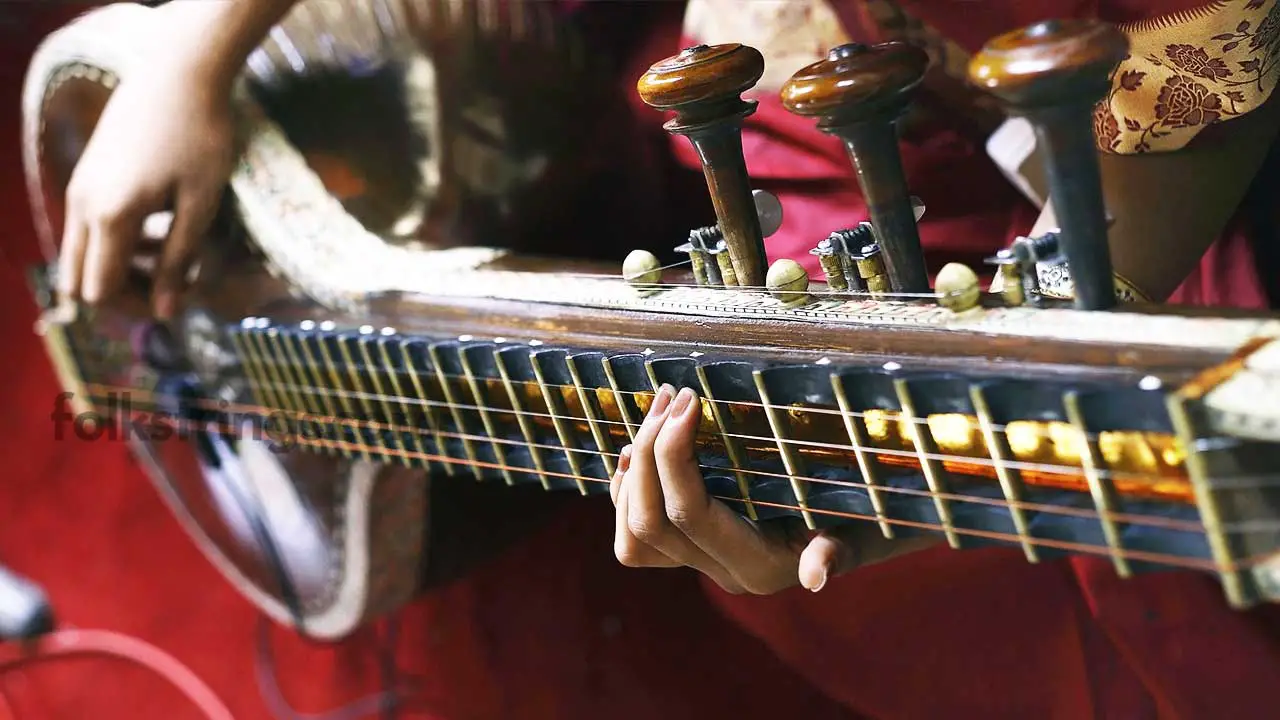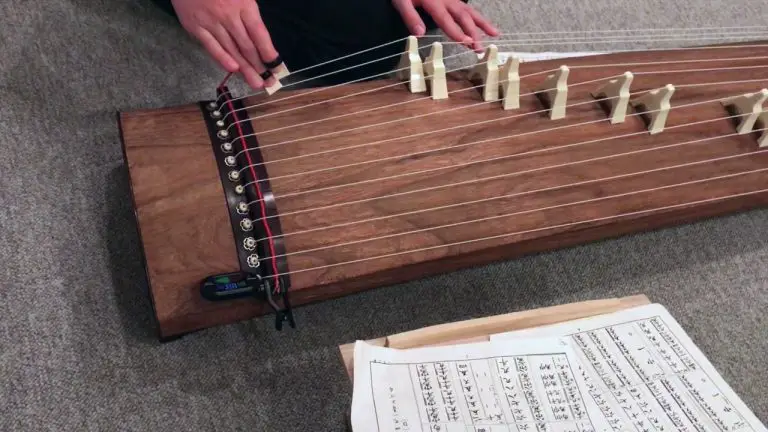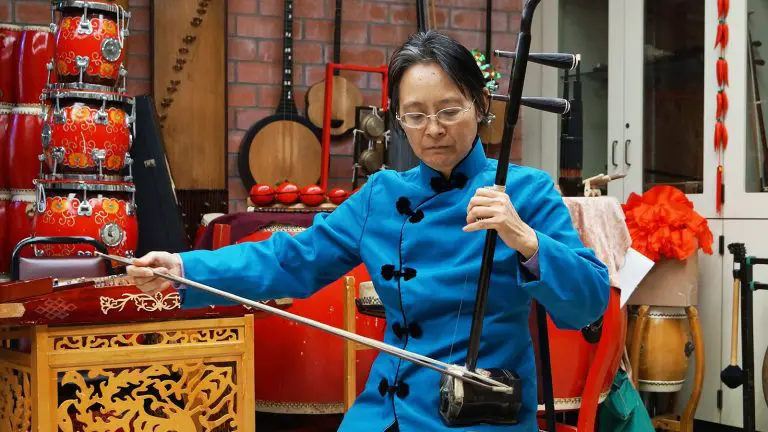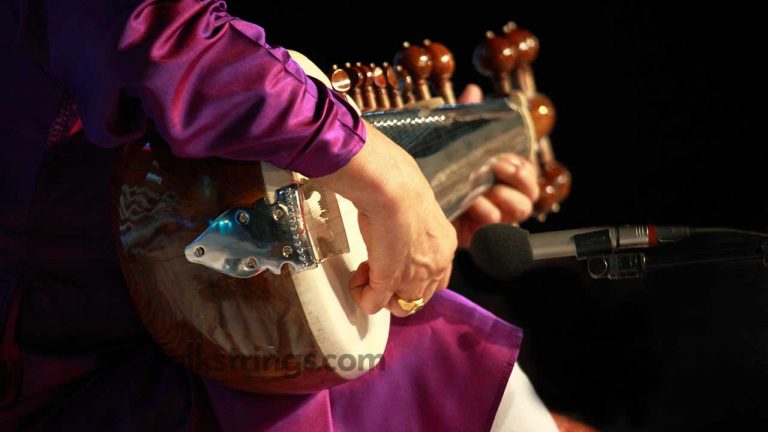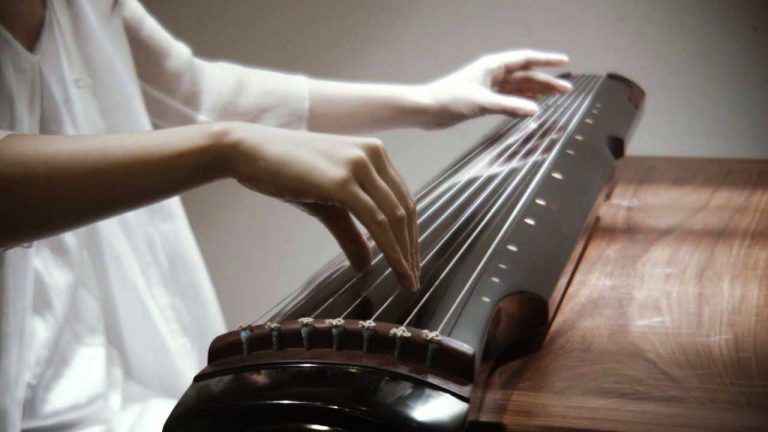Is Sitar Easier than Guitar? Your Questions Answered
Folkstrings.com is reader-supported. When you buy through links on our site, we may earn a small commission.
Sitars are plucked instruments originating from India and are used in classical Hindustani music. These instruments sound much like guitars, only with a reverberating buzz that makes them unique.
When you first see a Sitar, you might think it looks a bit like a guitar or a banjo. These instruments are about four feet long and have a pear-shaped body with a long neck and many tuning pegs, along with movable frets.
The number of strings on a Sitar varies between 18 to 21. There are typically 5 to 6 playable strings, 2 drone strings, and multiple sympathetic strings. Both the drone and sympathetic strings resonate, which is what gives the sitar its characteristic sound.
When playing the Sitar, most people sit. You hold this instrument at a 45-degree angle on your lap, using your right hand to pluck and the left hand to fret.
If you have been considering playing this amazing Indian instrument, you likely have a lot of questions. I hope to answer your questions with the information below to help you determine if the sitar will be your next instrument to master.
Table of Contents
- How Much Does a Sitar Cost?
- Is Sitar Easier Than Guitar?
- Can I Learn Sitar on My Own?
- Is Sitar the Same as Tanpura – What Are the Differences Between Sitar and Tanpura?
- What Is the Difference Between Sitar and Veena Instruments?
- Interesting Facts About the Sitar
- The Sitar Is One of India’s Most Beautiful Instruments
How Much Does a Sitar Cost?
Before delving too deeply into the subject of Sitars, it helps to know how much they cost. How much does a Sitar cost? The answer to this question varies greatly. If you were to purchase an antique sitar with a history, you are looking at thousands of dollars.
Although Sitars are still made around the world, they are more difficult to find than most stringed instruments. Because of their rarity, you are going to likely pay between $300 to $4500, depending on the craftsmanship of the instrument.
If you are buying a Sitar, knowing what to look for is essential. Ideally, you should investigate how much does a Sitar cost and play the instrument before you purchase. Taking along a teacher or other expert will help to ensure you choose the right instrument.
Is Sitar Easier Than Guitar?
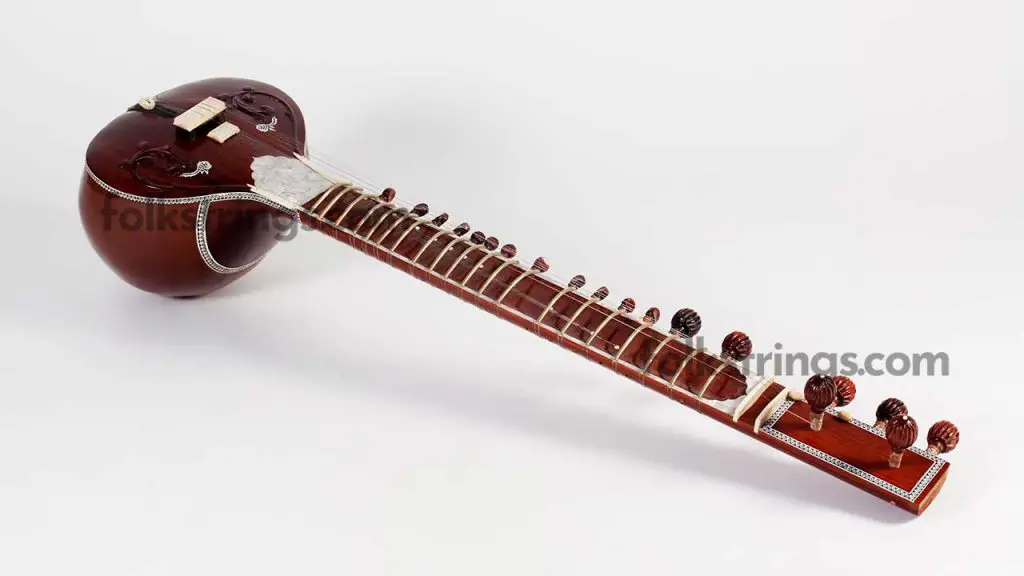
Because the two instruments resemble one another, many people want to know is Sitar easier than guitar.
While the Sitar and guitar are both stringed instruments that must be plucked with fingers or a pick, the similarities end there.
You would think if you know how to play guitar that the sitar would come like second nature, but this is not the case. Sitars are not tuned in fourths like guitars. Sitars have a much more complex playing style than guitars.
Is Sitar easier than guitar? The answer to this question is a resounding no. Sitars are extremely difficult to master and are not for beginner musicians.
I found playing the Sitar was much more difficult than a guitar. Although both guitars and Sitars are fretted, the number of strings on a sitar are greater, and you have to know how to use each one properly. You need to learn which ones play the medley and which are sympathetic strings.
The one or two drone strings accentuate the melody. Many people who know how to play guitar find themselves a bit overwhelmed in the beginning when they are learning to play Sitar. It’s not that this instrument is impossible to play, it is just such a different type compared to the guitar and some other stringed instruments.
Can I Learn Sitar on My Own?
I often hear people asking me, “Can I learn Sitar on my own?”. The answer to this question depends on your level of patience and the tools you have at your disposal. Yes, it is possible to learn the Sitar on your own, but you are going to need teaching tools to help you get started.
Depending on your part of the world, it may be difficult to find a teacher who offers sitar lessons. This instrument is not on the same popularity level as the guitar. If you are discovering it difficult to find a teacher, you may wonder can I learn Sitar on my own?
Thanks to today’s online world, there are many teaching tools at your disposal. YouTube is an excellent source for Sitar lessons, and there are many books on the subject as well.
Just as with any difficult instrument, it takes time to master the Sitar. This is not an instrument you can pick up and begin to strum a tune within a few minutes. You will need to ensure your interest level holds and you are able to stay dedicated to playing the Sitar before you start.
The reason you need such interest and dedication is due to the amount of time it will take to learn this instrument. For instance, in India, budding Sitar musicians begin with studying note recognition and theory for several years before they even begin playing. Imagine the dedication this requires!
Is Sitar the Same as Tanpura – What Are the Differences Between Sitar and Tanpura?

There are more Indian instruments than many people realize. If you’ve ever studied the Indian family of instruments, you have likely wondered how the Sitar and Tanpura are related.
Is the Sitar the same as the Tanpura? While there are undoubtedly similarities between the two instruments, there are also marked differences.
Because these instruments look so similar, they are sometimes difficult to differentiate. Before we get into the differences, I want to you to be aware of the similarities.
- Both of these instruments are made of wood.
- Both instruments are also traditionally made of gourds.
- Both of these instruments are stringed.
- Both instruments are plucked.
There are two primary differences between Sitars and Tanpuras. Unlike Sitars, Tanpuras have no frets and no sympathetic strings. The Tanpura is a simpler instrument, and many say it is easier to play.
Another difference between the two instruments is that the Sitar is more of a staple in Hindi music. The Sitar has made its way into mainstream music all over the world, thanks to musicians like George Harrison.
You will also find Sitars play melody, while the tanpura offers support to other instruments by playing continuous harmonic music. The Tanpura plays a base pitch. So, the answer to Is the Sitar the same as the Tanpura is no.
What Is the Difference Between Sitar and Veena Instruments?
The Veena is another Indian instrument, easily confused with the Sitar. At first look, the two instruments look very similar, though there are some key feature differences. The Veena has two basic versions. If you are are wondering what is the difference between Sitar and Veena, continue reading below to get the answers.
The Rudra Veena belongs to the zither family. The Saraswati Veena belongs to the lute family. Like the Sitar, the Veena has a gourd-shaped body and a long neck.
The key differences between the Sitar and the Veena are the following.
- While Sitars can have 21 strings, the Veena only has 4 strings.
- The Veena is lighter than the Sitar.
- The Sitar has one bridge, while the Veena has two bridges.
- Sitars always have frets, while some Veenas may not have them.
- A Sitar has 20 frets, while a Veena may have 24 frets.
The Veena is said to have risen from Indian mythology. This ancient instrument has gone through many changes over the years. Today’s modern version is based on Raghunathan Nayak’s 17th century rendition.
Both the Sitar and Veena are plucked when playing. When playing the Sitar and Veena, players usually remain seated because these instruments can be 4 to 5 feet long. Now that you know the answer to what is the difference between Sitar and Veena, you need to decide which one will offer you the playing style you prefer.
Interesting Facts About the Sitar
The Sitar is one of the most fascinating instruments from Indian culture. It is also the most popular among the Indian family of instruments. The following are some of the most interesting facts about the Sitar.
- The Sitar is over 700 years old.
- The origins of the Sitar are still unknown.
- The very first Sitar only had 3 strings.
- The Sitar is very difficult to master.
- It is challenging to fret a Sitar.
- India’s most famous Sitar player is Ravi Shankar.
- George Harrison learned to play the Sitar from Ravi.
- The Beatles were primarily responsible for bringing the Sitar to mainstream pop music in the 1960s.
- The Sitar is one of the most expensive instruments you can find in India.
- The most popular Sitar is the Kharak Pancham.
- There are four main parts to the Sitar, including the Dand, Tabli, Gulu, and Tumba.
- When properly maintained, Sitars can last up to 45 years. Some have been known to last more than 100 years.
- Sitars are difficult to make, taking up to twelve hours per instrument.
The Sitar Is One of India’s Most Beautiful Instruments
While India has a large family of instruments, the Sitar stands out as one of the most popular. The Sitar is a beautiful instrument with an even more beautiful history.
If you have never played the Sitar, it is certainly not an instrument you can pick up and learn to play overnight. Although Sitars are very difficult to play, they are worth it! The Sitar is instrumental in Indian culture and remains integral in Bollywood films.
Author Profile
-
Daniel Johnstone is an English writer with a love for stringed instruments from around the world.
He shares his love for these instruments through his writing for folkstrings.com, a website dedicated to all things related to folk string music.
Daniel's passion for music started at a young age, and he has since become an accomplished musician, playing guitar, cavaco, and recently, the harp.
His dedication to learning and sharing his knowledge of stringed instruments is evident in his insightful and engaging blog posts. Whether you're a seasoned musician or a beginner, Daniel's writing is sure to inspire and entertain you.
When he's not playing music or writing, you can find Daniel exploring new instruments and seeking out new sounds to share with his readers.
Latest entries
 AutoharpApril 4, 2024What Is the Autoharp Made Of: Exploring Its Materials and Craftsmanship
AutoharpApril 4, 2024What Is the Autoharp Made Of: Exploring Its Materials and Craftsmanship AutoharpApril 4, 2024Is Autoharp Easy to Play? Unveiling the Truth for Beginners
AutoharpApril 4, 2024Is Autoharp Easy to Play? Unveiling the Truth for Beginners AutoharpApril 4, 2024What Is an Autoharp Worth? Your Guide to Pricing and Value
AutoharpApril 4, 2024What Is an Autoharp Worth? Your Guide to Pricing and Value AutoharpApril 4, 2024Are Autoharp and Zither the Same Thing? Unraveling String Instrument Myths
AutoharpApril 4, 2024Are Autoharp and Zither the Same Thing? Unraveling String Instrument Myths
Affiliates:
This post may contain affiliate links that at no additional cost to you, the site may earn a small commission. We only recommend products we would use ourselves and all opinions expressed on this site are our own.
Accuracy Advice:
While we strive to provide up-to-date and accurate information, the content in this article may not reflect the most current research or medical guidelines. We encourage readers to do further research and consult with professionals for more personalized advice.
Our Recommendations:
The products and services mentioned in any of our articles are recommended based on our independent research and personal experience. We are not sponsored by any company. We aim to suggest products and services we believe are of high quality and could be beneficial to our readers.

